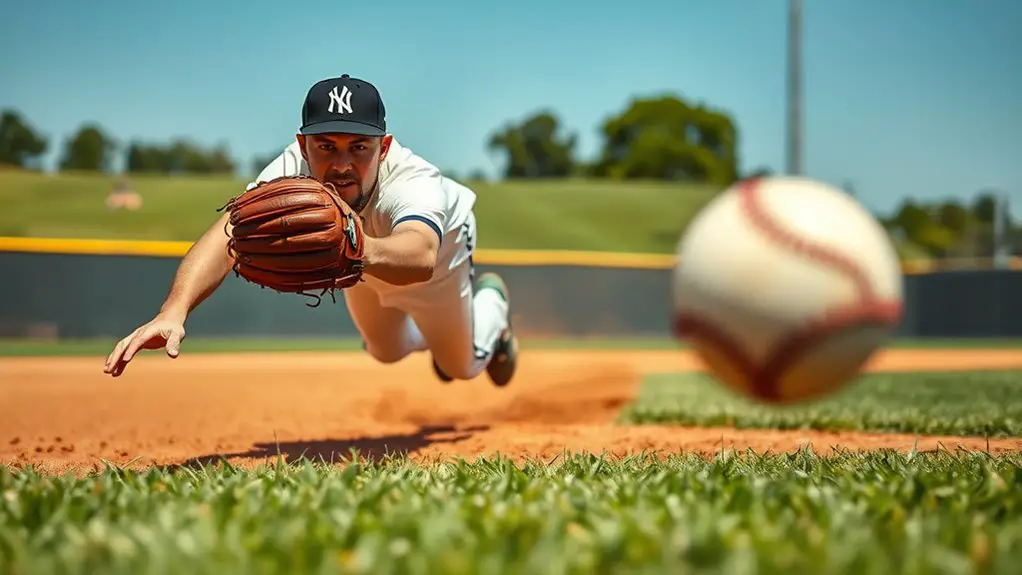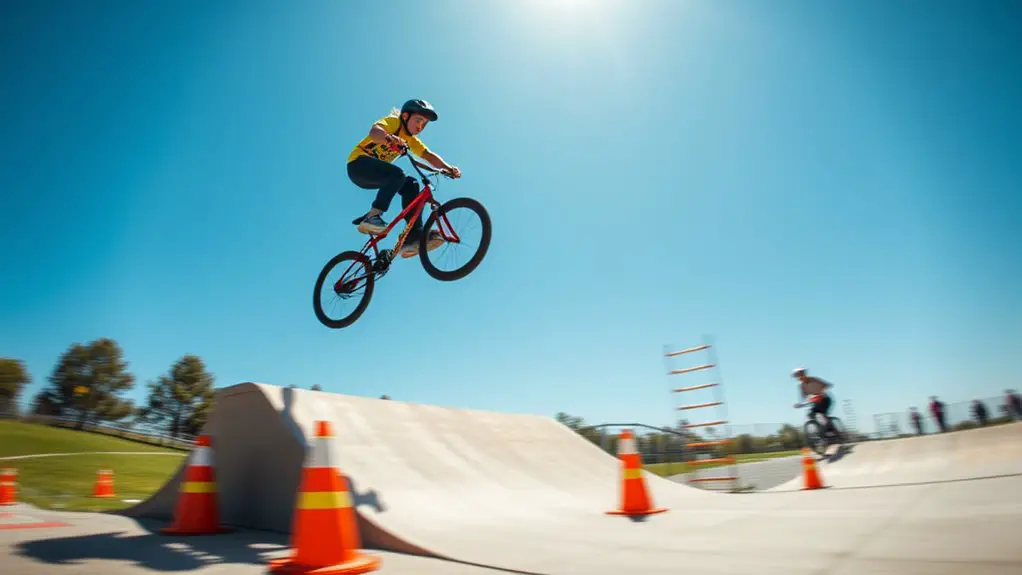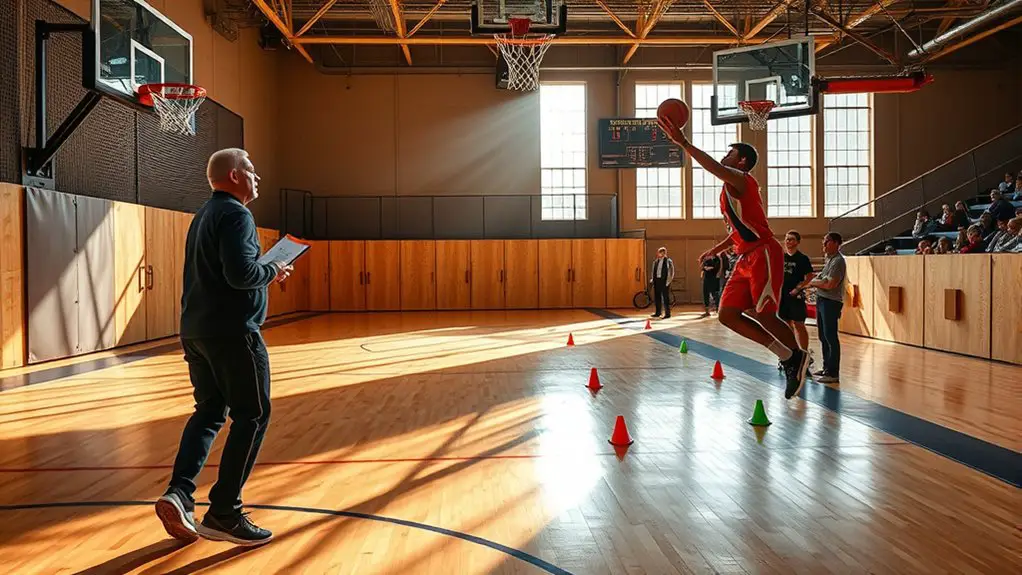To excel as an infielder, you need drills that sharpen your reactions. Ladder drills boost your footwork agility, while reaction ball drills will enhance your hand-eye coordination. Partner toss drills sharpen your quick response times, and cone drills improve your directional agility. Game simulation drills mimic live scenarios to develop your situational awareness on the field. With the right combination of these drills, you'll see significant improvement in your performance. There's even more to explore!
Ladder Drills for Footwork Agility
Ladder drills are essential for improving footwork agility in infielders. When you incorporate ladder techniques into your training, you're not just working on speed; you're enhancing your overall agility benefits. These drills challenge your coordination and foot speed, allowing you to move with more freedom on the field.
As you practice, you'll notice how quickly you can shift your weight and change directions, giving you a competitive edge during games. Each step you take on the ladder builds muscle memory, so when you're fielding ground balls or covering bases, your movements are instinctive and fluid.
Plus, the rhythm and precision required in ladder drills can boost your confidence. You'll feel the difference as you fly around the diamond, knowing your footwork is sharp and ready. Embrace these drills, and watch your agility soar, transforming your infield play into an art form. Consistency in practice is key to achieving significant improvements in athletic performance.
Reaction Ball Drills for Hand-Eye Coordination
Reaction ball drills are a fantastic way to enhance your hand-eye coordination, essential for infielders. These reaction ball exercises are designed to improve your reflexes and your ability to track moving objects. Grab a reaction ball and start by tossing it against a wall; the unpredictable bounces will challenge your quick reactions. As you get comfortable, increase the intensity by using two balls or incorporating movement, like shuffling or sprinting to catch the ball.
Partner Toss Drills for Quick Responses
While practicing with a partner might seem straightforward, partner toss drills are vital for developing quick responses in infielders. These drills focus on quick exchanges between you and your partner, enhancing your ability to react swiftly to the ball. Start by standing a short distance apart, tossing the ball back and forth. As you progress, vary the speed and angle of your throws to keep things unpredictable.
Effective partner communication is important during these drills. Make sure to call for the ball, signaling your readiness to react. This not only hones your reflexes but also builds trust between you and your partner.
As you become more comfortable, increase the intensity and distance between tosses. This will challenge your reactions even further. Remember, the goal is to cultivate a sense of freedom in your movements, allowing you to respond instinctively during games. To maximize your improvement, consider incorporating mental alertness and awareness techniques to enhance your overall reaction time.
Cone Drills for Directional Agility
Cone drills are essential for enhancing directional agility in infielders. By strategically setting up cones, you can develop quick lateral movements and improve your reaction times. Focus on effective cone placement to challenge your footwork and body control.
Start with simple patterns, like zigzags or T-drills, to get comfortable. As you progress, incorporate agility techniques like sprinting, shuffling, and backpedaling around the cones. This not only builds your speed but also sharpens your ability to change direction on a dime—crucial for infield play. Additionally, remember that strength training enhances muscle power for directional changes, which can significantly impact your agility.
Don't hesitate to mix it up! Adjust the distance between the cones to keep your drills engaging and challenging. Experimenting with different formations can help you find what works best for your style. Remember, the goal is to feel free and fluid in your movements, allowing you to react instinctively during games. So, grab those cones and start sharpening your agility!
Game Simulation Drills for Real-Game Scenarios
To truly prepare for the intensity of a game, you need to incorporate game simulation drills that mimic real-game scenarios. These drills help you develop the situational awareness that's essential on the field. Start by setting up a scrimmage where you can practice different plays, such as double plays or cut-offs. This not only builds your reaction time but also sharpens your decision-making skills in high-pressure situations.
Another effective drill is to work with a coach or teammate who can randomly hit ground balls or line drives. You'll have to react quickly, analyzing the game scenarios as they unfold. Consider incorporating base runners to simulate the chaos of a live game, forcing you to think on your feet. By immersing yourself in these realistic situations, you'll gain the confidence and instincts necessary to excel when it counts the most.
Frequently Asked Questions
How Often Should Infielders Practice Reaction Drills?
Practicing reaction drills regularly is essential for enhancing your skills. Ideally, you should dedicate time to these drills at least two to three times a week. This frequency helps improve your reaction time, allowing you to respond quickly during games. Don't forget to mix up the drills to keep things fresh and engaging. You'll not only boost your performance but also enjoy the freedom of becoming a more agile and responsive player on the field.
What Age Group Benefits the Most From These Drills?
When you think about skill progression, you can't overlook the importance of youth development. Young players, especially those aged 8 to 14, benefit the most from reaction drills. They're at a stage where their skills are rapidly evolving, and these drills help them enhance their reflexes and decision-making. By focusing on this age group, you're setting the foundation for their future success, allowing them the freedom to grow and excel on the field.
Can These Drills Be Done Indoors?
Absolutely, you can do these drills indoors! With the right indoor equipment, you can create a space that allows for effective practice. Just be mindful of space limitations; make sure there's enough room to move and react. You might need to get a bit creative with your setup, but it's definitely doable. Indoor drills can keep your skills sharp, especially when outdoor conditions aren't ideal. So, embrace the freedom to train anywhere!
How Long Should Each Drill Session Last?
When considering drill duration, you should aim for about 20 to 30 minutes per session. This keeps your focus sharp without wearing you out. As for session frequency, try to practice two to three times a week to maintain your skills without feeling overwhelmed. Remember, it's all about finding that balance between intensity and enjoyment, so adjust as needed to fit your schedule and energy levels. You've got this!
Are There Specific Drills for Advanced Infielders?
They say, "Practice makes perfect," and that's especially true for advanced infielders. You'll want to focus on drills that enhance your situational awareness and advanced techniques. Incorporate scenarios that challenge your decision-making and reflexes, like reaction time drills with unpredictable bounces. Mix in live batting practice to simulate game conditions, allowing you to sharpen your instincts. Remember, it's all about refining your skills and adapting to the ever-changing game.




